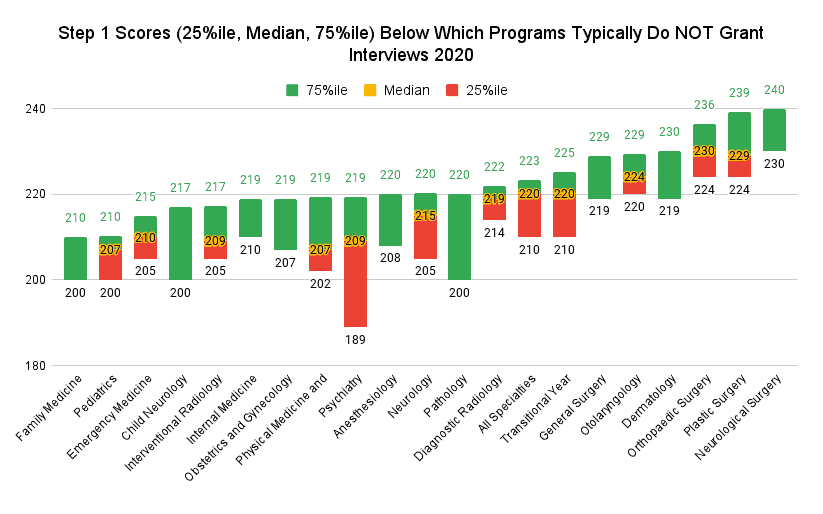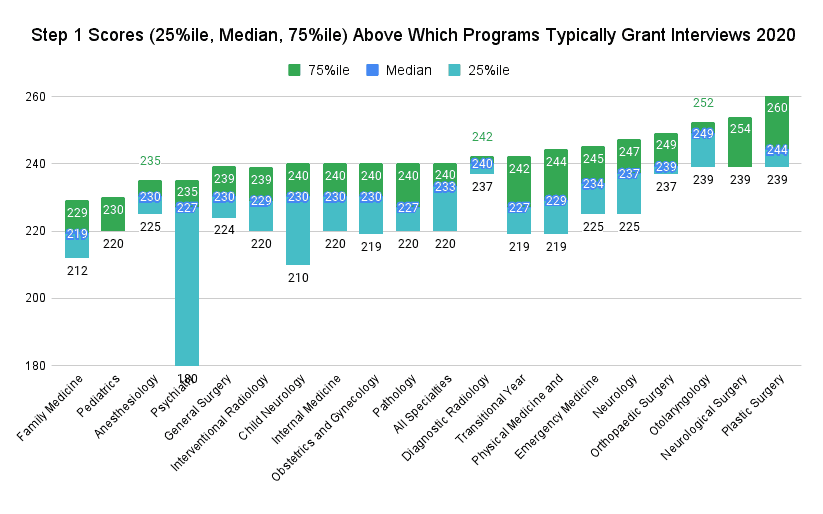
Recently I tried to open a door, but it wouldn’t budge. I tried the next door. Nothing. Eventually, I realized I was pushing from the wrong direction. This is not an uncommon experience (I’m clumsy). However, I started thinking about how medical students seek their dream residency. It’s an apt analogy. Pushing from the wrong direction will always lead to a closed door.
To open a door, the key is to know what direction to push from.
The stakes for residency applications are stratospheric. The typical residency program received 1013 applications for the 2021 Match. Programs immediately rejected 50% of those applications based on a “standardized screening process.” Of the applications reviewed in-depth, programs only sent out 249 interview requests. Of those who interviewed, only 101 were actually ranked. A fraction of those ranked actually matched at a given program.
And those are averages. The numbers are more bleak for the most competitive specialties, cities, or hospitals.
How do you stand out from the hordes of brilliant, hard-working medical students? Do you volunteer at the free clinic? Shadow? Take on extra projects, do research, or focus on Step 1?
What Exactly Are Programs Looking For?
Not all hard work is equal. 10 hours doing research isn’t the same as 10 hours of Step 1 studying or 10 hours of volunteering. We all have the same 24 hour day. How we apportion that time will determine our residency chances.
In this article, we will enter the minds of residency program directors. We will explore the exact criteria they use in deciding who to interview, and who to reject. Only 25% of applicants are invited to interview. As such, this is often the the biggest hurdle in residency applications.
The great news is that we have the exact means to read program directors’ minds. It’s called the NRMP Residency Program Director Survey. To compile it, every 2 years, the NRMP surveys every single residency program director. Their purpose? To identify the most important criteria program directors use when offering interviews. It’s from actual program directors. NOT your sister’s friend’s uncle who used to serve on an admissions committee twenty years ago. Not that senior who claimed they had no connections, but secretly was doing research with the program director. From the actual people holding the keys to your residency fate.
Summary:
- Your USMLE Step 1 score is one of the most essential factors in obtaining an interview.
- Preclinical grades may not matter as much as you think.
- Choose a few extracurricular and volunteer experiences that interest you instead of aiming for a high quantity of experiences.
- Research and Personal Connections can help your application stand out, even if you have lower Step scores.
- Don’t stretch yourself too thin trying to do everything. Know your goals and focus on the steps you need to take to achieve them.
Table of Contents
The Data: How to Get an Interview
First, the data. Let’s start by looking at the combined responses of all program directors. Combining these responses allows us to see broad patterns. This is particularly important if you are considering multiple fields.
| Characteristics Considered in Deciding Whom to Interview | % Program Directors Citing As Important | Average Importance Rating |
|---|---|---|
| USMLE Step 1 Score | 86.2% | 3.7 |
| MSPE | 85.9% | 4 |
| Letters of Recommendation in Specialty | 85.1% | 4.2 |
| Personal Statement (Overall) | 83.8% | 3.9 |
| Diversity Characteristics | 80.9% | 4.1 |
| Perceived Commitment to Specialty | 79.5% | 4.3 |
| USMLE Step 2 CK Score | 78.8% | 3.8 |
| Having Overcome Significant Obstacles | 75.5% | 4.1 |
| Grades in Required Clerkships | 74.6% | 3.9 |
| Any Failed USMLE Attempt | 74.1% | 4.4 |
| Professionalism and Ethics | 73.9% | 4.5 |
| Perceived Interest in Program | 72.3% | 4.2 |
| Leadership Qualities | 70.1% | 4.2 |
| Class Ranking/Quartile | 68.1% | 3.8 |
| Grades in Clerkship in Preferred Specialty | 65.2% | 4.1 |
| Volunteer/Extracurricular Experience | 64.8% | 3.9 |
| Personal Prior Knowledge of Applicant | 63.6% | 4.1 |
| Other Life Experience | 62.8% | 3.9 |
| Any Failed COMLEX-USA Attempt | 59.4% | 4.4 |
| Consistency of Grades | 58.5% | 3.9 |
| COMLEX-USA Level 1 score | 55.9% | 3.7 |
| Awards/Honors in Clinical Clerkships | 55.0% | 3.4 |
| COMLEX-USA Level 2 CE Score | 53.0% | 3.8 |
| AOA Membership | 50.6% | 3.5 |
| GHHS Membership | 50.5% | 3.6 |
| Passing USMLE Step 2 CS | 46.4% | 3.6 |
| Awards/Honors, Clerkship in Preferred Specialty | 46.2% | 3.7 |
| Continuous Medical Education w/o Gaps | 46.2% | 3.8 |
| Audition Elective/Rotation in PD's Dept | 44.8% | 4.2 |
| Medical School Accreditation Status | 44.2% | 4.2 |
| Involvement and Interest in Research | 41.1% | 3.6 |
| Medical School Reputation | 38.1% | 3.7 |
| Ability to Work Legally w/o Visa | 35.5% | 4.2 |
| Visa Status | 33.4% | 3.9 |
| Passing COMLEX-USA Level 2 PE | 31.8% | 3.7 |
| Fluency in Language of Pt Population | 31.0% | 3.6 |
| NRMP Flag for Match Violation | 27.8% | 4.7 |
| Interest in Academic Career | 24.2% | 3.8 |
| Awards/Honors in Basic Sciences | 22.9% | 3.2 |
| Sigma Sigma Phi Membership | 21.0% | 3.4 |
| Away Rotation in Specialty Elsewhere | 18.9% | 3.8 |
| USMLE Step 3 Score | 12.6% | 3.2 |
| COMLEX-USA Level 3 Score | 8.9% | 3 |
| How Medical School Handled Virtual Rotations | 6.6% | 3 |
What exactly do these numbers mean? The first number is the number of programs who said this factor was important. The second number is the average importance rating. In other words, USMLE Step 1 was used by 86.2% of all residency programs that responded to the survey. Those programs gave Step 1 an average importance of 3.7. Ratings on a scale from 1 (not at all important) to 5 (very important).
1. Step 1: Minimum Scores Are Often Necessary – and Top Scores Sufficient – to Get an Interview
What do the numbers tell us? The first thing you’ll notice is how important Step 1 is. Virtually every single program requires that you take it. Even more, when you drill down into the data, many programs said they have a target score for their Step 1 exam.
Why would Step 1 be so important? An obvious reason is that programs need a way to compare vast numbers of students on an equivalent basis. As stated before, programs only offer ~25% of all applicants an interview. Of the 924 programs who responded in the 2020 Program Director Survey, 360 (39%) said they have a target Step 1 score. 337 (37%) of programs stated that there was a score under which they generally don’t grant interviews. The mean cutoff score? A Step 1 score in the 220s.
Note: While most of the data on this page is from the 2021 Program Director Survey, the interview cutoff scores were not included in the 2021 results. This information is taken instead from the 2020 Program Director Survey.
Here are the reported Step 1 cutoff scores from the 2020 Program Director survey.

Step 1 Scores (25%ile, Median, 75%ile) Below Which Programs Typically Do NOT Grant Interviews, 2022 Program Director Survey
What Scores Do You Need to Virtually Guarantee an Interview?
Conversely, 281 (30.4%) stated that there was a score above which they would generally invite applicants to an interview. In other words, many programs will give you an invite based off a high Step 1 score alone. The magic score? The mean was in the 230s. (Note that the spread was broad, ranging from about 220 for the 25%ile to 240 for the 75%ile).
Here are the reported Step 1 scores (25%ile, median, and 75%ile) above which programs would usually grant interviews.

Step 1 Scores (25%ile, Median and 75%ile) Above Which Programs Almost Always Grant Interviews; 2020 Program Director Survey
If you’re below a program’s Step 1 cutoff, your extracurriculars won’t matter. It won’t matter how many committees you served on, doctors you shadowed, or times you volunteered at the free clinic.
Have you ever told yourself, to stand out, you need to do more than “just study for Step 1.” If you’re mastering the material and learning how to apply it, then by all means start doing research. However, be careful that you’re not doing these things INSTEAD of studying for Step 1. Many people hope to do well on Step 1 AND excel at other things. Yet, they end up struggling at everything by spreading themselves too thin.
This squared with my experiences. When I applied, I had only taken Step 1 and had scored 270. Despite not having taken Step 2 CK or CS, all but one program I applied to granted me an interview.
Getting an interview is important. Being among the first to receive an invitation – to secure your preferred dates – is equally important. On the strength of my Step 1 score, I received my first-choice date at all my interviews. I grouped all my interviews together by location. This saved time, money, and hassle. I completed all my California interviews within two weeks. I bought a one-way ticket to New York, and had all 4 of my New York interviews within the same week. Then I took the bus to Boston and had all 4 of my Boston interviews the week after that. My last interview was on December 13, before most programs had seen half their interviewees.
The take-away? Don’t sacrifice your Step 1 preparations in trying to stand out with extracurriculars.
2. Where Are the Preclinical Grades??
Another item is significant for its absence. While core clerkship grades are the #9 most cited item, preclinical grades aren’t even on the list.
Wait, so our preclinical grades don’t matter?
What gives? More and more schools have “pass-fail” grading for their preclinical years. As such, it would make sense that program directors would ignore preclinical grades. For many schools it’s just a bunch of “Passes.”
Still, while it’s not cited as a factor by itself, there are ways in which it may matter. First, the MSPE (formerly the Dean’s Letter) can vary widely in what it includes. Some schools have “pass-fail” grading, but they could include rankings in the MSPE. Second, student rankings may determine AOA (medical honors society).
My takeaway? Ask your school how the MSPE presents preclinical grades/rankings. If it’s not included, stop worrying so much about them! Most students waste time worrying about maximizing their scores on preclinical exams. Instead of doing their Anki cards, they’ll cram for midterms. Or they’ll memorize PowerPoint minutiae for their tests rather than understand it.
This short-term approach can hurt your residency chances. They will be scrutinizing Step 1, not your preclinical grades. Med school exams focus on memorizing information. Step 1 focuses on mastery/application of the material. If you learn the Step 1 material properly, you can still do well on your med school exams. However, cramming for your preclinical tests will only hurt your Step 1 score.
3. Residency Programs Rely on High-Level, Summative Assessments to Screen Applicants
A successful application begins with considering each program’s goals and limitations. Remember, a typical program can only offer interviews to 25% of applicants. Their goal is to find the best applicants who are a “fit” for their program. However, their time is limited. This is particularly true when deciding who to interview.
A careful reading of the survey further confirms this sobering fact. Every program surveyed has a “standardized screening process.” This screen eliminated 50% of all applicants.
Fewer than 45% of all applicants received an “in-depth review.”
We’ve already seen that Step 1 is used as a screening tool. Low Step 1 scores may lead to outright rejection, while high scores may lead to an automatic interview.
It can be terrifying to have years of your life summarized in a three-digit score. For program directors, Step 1 is a tool they use to sort between large numbers of applicants.
The other top-cited factors for extending interviews share a similar summative quality. Let’s look at the top 4 cited factors again (mean importance ratings in parentheses).
- USMLE Step 1 score – 86% (3.7)
- Medical Student Performance Evaluation (MSPE/Dean’s Letter) – 86% (4)
- Letters of Recommendation in Specialty – 85% (4.2)
- Personal Statement – 84% (3.9)
What do you see? Half of the factors cited are summative – Step 1 and your MSPE. The others look to assess “fit” with the specialty. Your Personal Statement assesses your motives. Your LORs tell them how specialists in the field think you’ll do.
What does this mean for you? I remember obsessing about the perfect way to phrase my experiences as a French camp counselor in my residency application. Now I know that was a waste of time. They’re busy. They are looking for high-level summaries of what you’ve done. One interviewer told me all he looked at were the school and Boards scores. That is an extreme example, but it speaks to how pressed for time the people evaluating you are in many ways.
4. The Quantity of Volunteer/Extracurricular Experiences Isn’t Important
One of the first days as a medical student was our activities fair. Older medical students set up tables, explaining the various organizations they ran. There were groups for everything you could imagine. Groups for specialties, for research, and for student government. There were groups devoted to meditation (a group I started), business, and many others.
All the groups had a common theme. The second-years leading them would begin their Step 1 studying/enter clerkships soon. As such, there would be a need (nay, an opportunity!) for eager first-years to participate and take on leadership positions.
You could see the frenzy of first-year students hoping to stand out in some way rushing to participate in various groups. I was one of them.
In retrospect, particularly when looking at the cold, hard data of the program director survey, I regret some of my earlier decisions. Some extracurriculars I participated in were things I genuinely was interested in, like meditation. Others, however, I did because I was afraid of “missing out” on an opportunity to stand out later. Some of my classmates volunteered at the free clinic because of a belief in social justice. Many others, including myself, did it because it felt like something we were supposed to do.
It’s these one-off sorts of experiences that I regret. They never came up in my interviews, and likely didn’t pass as a thought by the program directors.
The data bear this out.
Volunteer/extracurricular experiences rank as #16 on the list. Only about half of programs said it was significant in deciding who to interview.
The same is true when we look at people who actually matched vs. didn’t match in their chosen specialty. There’s little correlation between the number of experiences, and the chance of matching.
| Step 1, US Senior (Matched) | Step 1, US Senior (Unmatched) | Mean number of volunteer experiences, US Senior (Matched) | Mean number of volunteer experiences, US Senior (Unmatched) | |
|---|---|---|---|---|
| Plastic Surgery | 251 | 240 | 9.2 | 7.8 |
| Otolaryngology | 250 | 243 | 9.2 | 8.2 |
| Dermatology | 248 | 244 | 11 | 9.3 |
| Orthopaedic Surgery | 248 | 241 | 8.9 | 7.5 |
| Neurological Surgery | 248 | 238 | 7.6 | 7 |
| Interventional Radiology | 245 | 238 | 7.6 | 7.7 |
| Diagnostic Radiology | 245 | 233 | 7.2 | 6.2 |
| Vascular Surgery | 241 | 238 | 7.1 | 6.6 |
| Radiation Oncology | 240 | 209 | 8 | |
| General Surgery | 237 | 225 | 8.9 | 7.8 |
| Anesthesiology | 237 | 221 | 7.7 | 6.5 |
| Internal Medicine | 237 | 218 | 7.7 | 6.3 |
| Internal Medicine/Pediatrics | 236 | 217 | 10.3 | 8.2 |
| Obstetrics and Gynecology | 234 | 225 | 10.2 | 9.1 |
| Emergency Medicine | 234 | 219 | 8.2 | 6.9 |
| Child Neurology | 234 | 214 | 7.8 | 7 |
| Neurology | 233 | 217 | 7.5 | 6 |
| Pathology | 233 | 226 | 6 | 5.3 |
| Pediatrics | 230 | 209 | 9.3 | 7 |
| Physical Medicine and Rehabilitation | 230 | 220 | 8.9 | 8 |
| Psychiatry | 228 | 219 | 8.1 | 7.1 |
| Family Medicine | 225 | 211 | 8.3 | 5.5 |
My takeaway? I’d choose one, at most two, non-research extracurriculars you want to participate in. Even then, I would be careful to choose only personally meaningful things. Unless it’s truly spectacular, it may not move the needle for residency programs.
As always, be mindful of the opportunity cost. Every free evening, afternoon, or weekend you give up is less time you can spend on other goals. Don’t ask yourself, “if I did Activity X, would it help me?” Instead, ask yourself, “what priority am I willing to sacrifice to do Activity X?” Only do an activity if there is a different activity you are willing to compromise.
5. Research and Personal Connections Help You Stand Out in Competitive Specialties
Residency programs care little for extracurricular activities. However, they care a great deal about research and personal connections. This is particularly true for the most competitive specialties. Let’s look at the two most competitive specialties in the 2022 Match, based on average Step 1 scores: plastic surgery and ENT.
The average Step 1 score for successful US Seniors in Plastic Surgery was 251. For ENT, the average was 250. (Dermatology and Orthopedic Surgery, the next two on the list, were both 248). That is insanely high. Even more surprising? The average Step 1 scores of those who didn’t match: 240 for plastic surgery and 243 for ENT.
Does that mean that if I score a 239, I can kiss my derm chances goodbye? No. Rather, it means that a high Step 1 score is necessary, but not sufficient, to get into a competitive residency.
One of the most important non-Boards factors is research. Here is a comparison of matched and unmatched US seniors, sorted based on Step 1 scores. Often, the Step 1 scores are similar between matched and unmatched applicants. Rather, there is a significant gap in the numbers of research abstracts, papers, etc. they published.
| Step 1, US Senior (Matched) | Step 1, US Senior (Unmatched) | Mean number of abstracts, presentations, and publications, US Senior (Matched) | Mean number of abstracts, presentations, and publications, US Senior (Unmatched) | |
|---|---|---|---|---|
| Plastic Surgery | 251 | 240 | 28.4 | 13.8 |
| Otolaryngology | 250 | 243 | 17.2 | 11 |
| Dermatology | 248 | 244 | 20.9 | 15.7 |
| Neurological Surgery | 248 | 238 | 25.5 | 11.7 |
| Orthopaedic Surgery | 248 | 241 | 16.5 | 12.1 |
| Diagnostic Radiology | 245 | 233 | 8 | 7.2 |
| Interventional Radiology | 245 | 238 | 12.2 | 7.2 |
| Vascular Surgery | 241 | 238 | 12.4 | 11.3 |
| Radiation Oncology | 240 | 209 | 13.3 | |
| Anesthesiology | 237 | 221 | 6.6 | 4.4 |
| General Surgery | 237 | 225 | 8.6 | 5.3 |
| Internal Medicine | 237 | 218 | 6.9 | 3.5 |
| Internal Medicine/Pediatrics | 236 | 217 | 6.5 | 5.5 |
| Child Neurology | 234 | 214 | 7.4 | 2 |
| Emergency Medicine | 234 | 219 | 5.1 | 2.7 |
| Obstetrics and Gynecology | 234 | 225 | 6.8 | 5 |
| Neurology | 233 | 217 | 7.8 | 7.6 |
| Pathology | 233 | 226 | 8.5 | 1.7 |
| Pediatrics | 230 | 209 | 5.6 | 5.9 |
| Physical Medicine and Rehabilitation | 230 | 220 | 6.2 | 3.9 |
| Psychiatry | 228 | 219 | 6.2 | 4.2 |
| Family Medicine | 225 | 211 | 4.1 | 2.6 |
Another thing that stands out about the program director survey is the emphasis on personal knowledge of the applicants. For example, 82% of dermatology program directors cited “Personal prior knowledge of the applicant” as significant in deciding who to interview. Even more important, the average rating of importance given was 3.9.
What’s my takeaway if you want to get into a competitive specialty? First, while a top Step 1 score is critical, it isn’t enough by itself. Second, to stand out, research continues to be a differentiating factor.
Note that the dedication to studying required to do well on Step 1 is often at odds with doing proliferative research. Unless you’re a savant, it is difficult to do both well. Instead, many people choose to take a year off to focus on research and to shadow/build connections in their given specialty.
Concluding Thoughts
Getting into your dream residency may feel overwhelming. It doesn’t have to be. Knowing what program directors are looking for in applicants is clarifying. You don’t have to work until exhaustion, trying to do anything and everything to stand out. Instead, be clear about what your goal should be at every stage.
If you’re a preclinical student, your emphasis should be squarely on doing well in Step 1. In your clerkships, while your grades matter, so does Step 2 CK. At any stage, Anki is a fantastic means of working towards mastery of these long-term goals.
If you’re interested in the most competitive specialties, not only do you need to do well on your Step 1, you will also likely need to stand out in some other way. Research is a common approach, but if you are struggling to do both simultaneously, it’s ok to focus on your curriculum now and plan to do a research year later.
My most important takeaway from the program directors’ survey is prioritization. I’ve found in many different areas that the most successful people are those who have a clear idea of their end goal, and focus on the few levers that deliver an outsized likelihood of achieving it. With data, we can make better decisions so that when we push on the door, it opens the first time.
Sources:









Hello Dr Alec
I managed to score decently on Step 1 but had a drop off in my Step 2 CK. Scored well in my assessments but I guess I just had a bad day.
In light of all the changes happening, how much of a red flag is this on my application? Am looking to apply IM at a not-too-competitive place, hopefully in California. Should I give up on this pursuit? Or should I look at other ways to strengthen my application?
Hi NS. I’m so sorry to hear that your scores were below where you were hoping. Without knowing the scores/more about your background I can’t give much in the way of specific advice. You can use this article, though, to help with assessing where your scores would be relative to other people who matched: https://www.yousmle.com/step-percentiles/
Dr. Palmerton
Dr Alec, I am an International medical student and am preparing to match Neurology. I am completely new to Publications/Poster presentations.Where can I learn how to make them/present them etc?
Much thanks! Your website is the best I’ve come across!
Hi Alec,
I’m an IMG from India. Your articles have been very helpful, just a small doubt how important is it for someone to do electives, because observerships are rarely considered as USCE bythe programs in states.
Is a good score(250+) enough?
Hi Alec, I would first like to thank you for helping all of us with our medical school journeys. I no longer feel like I know nothing about what to do with my future.
I had a question regarding the research experiences: Are publications only related to the speciality considered useful? Like in pediatrics, the mean number is 4, so if somebody had a paper published on a subject not related to pediatrics, would it not be considered in the 4? If I wanted to apply for a residency in pediatrics but had a paper already published in any other unrelated topic/speciality, would that published paper not be helpful during applying as it isn’t related to pediatrics?
Thank you for any advice on the matter.